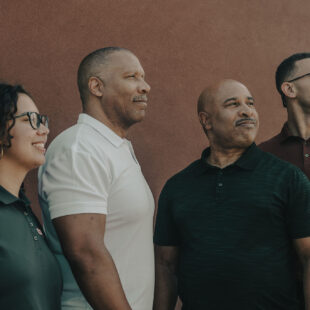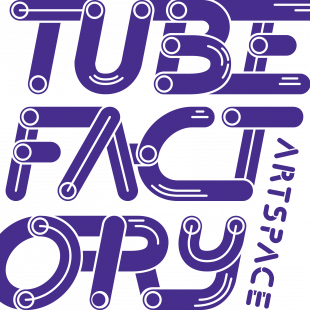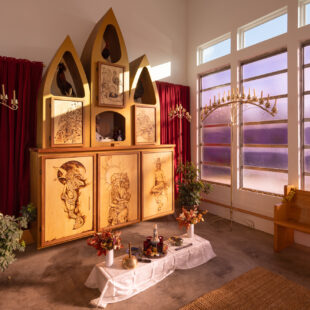Note: the video above is from 2020. View this video to see the campus as it looks more recently.
The Artist and Public Life Residency (APLR) is an affordable housing program with 18 homes on one block surrounding Tube Factory artspace. These are a combination of co-ownership between the artist and Big Car and affordable rentals that are priced at about 50 percent below market rate.
Learn about our current long-term artist residents here.
The program began taking shape in 2016 as a partnership between Big Car Collaborative and Riley Area CDC, a nonprofit community development nonprofit. Big Car co-founders Jim Walker, Shauta Marsh and other Big Car staff and consultants (including artist and planner Danicia Monet) researched and developed the program based on best practices around the country and world and our own innovative approaches.
The first artist moved into the program in 2018. Since then, sixteen of the eighteen homes have undergone completed renovations of up to $150,000. All homes are currently full with 28 artists and their family members.
APLR is unlike nothing else in our city and has gained much national and international attention. The program and the renovations of the homes are made possible through support of Glick Philanthropies, Lilly Endowment, the Herbert Simon Family Foundation, Allen Whitehill Clowes Charitable Foundation, the Indianapolis Neighborhood Housing Partnership (INHP), Efroymson Family Fund, Impact 100, and others.
How it works: artists are selected by a panel of neighbors that have lived in Garfield Park 15 plus years, other APLR artists, a Big Car staff artist, and regionally known artists who use their practice to work in community.
APLR— supports community leaders who team up with neighbors (and others across the city) to strengthen our block, the southside, and the broader community through arts-based approaches. A key part of our Cruft Street Commons work on a single block on the near southside of Indianapolis, our long-term affordable artist housing collaborative — known as the Artist and Public Life Residency (APLR) — supports community leaders who team up with neighbors (and others across the city) to strengthen our block, the southside, and the broader community through arts-based approaches.
For this program, we consider artists to be creatives, makers, teachers, designers, and more. Fields include — and are not limited to — architecture, culinary art, curation, visual art, public art, furniture, fashion, craft, design, film and video, creative writing and journalism, performing arts, music, theater, placemaking, socially engaged art, etc. We also welcome leaders who work in nonprofit cultural or community organizations and educators who share their love of art, creativity, and community with their students.
In addition to the discount, being part of APLR also comes with shared resources such as access to shared resources as well as marketing and professional development support from our staff led by Big Car co-founder and director of programs and exhibitions, Shauta Marsh.
Community involvement: We’ve worked, every step of the way, with input from existing neighbors (whom we are dedicated to retain). And all aspects of APLR match with goals of the quality of life plan for our neighborhood that focuses heavily on affordable housing, avoiding displacement, and bringing artists to the southside.
Our biggest goal with APLR is to create a perpetual system to avoid future displacement of artist neighbors from affordable housing while they collaborate with other neighbors to boost the community’s culture, creativity, livability, safety, health, and economy. In both the co-ownership and rental options, costs are adjusted for affordability and the residency is linked to work — often together with other artists in the program — in support of the neighborhood and broader community.
The APLR program works as sort of an exchange of work in the community (about 16 hours per month) via their artistic practice for deeply discounted housing costs.
Read local and international media coverage of the project here.
History of APLR
In partnership with Riley Area Development and supported by Indianapolis Neighborhood Housing Partnership (INHP), the APLR program includes houses that were previously vacant, some for a long time, and no existing residents were displaced. These efforts for APLR are happening in partnership with current residents as a way to work together to further strengthen the neighborhood and keep affordable housing for artists in place. Our partner, South Indianapolis Quality of Life Plan and others are also working on strategies for affordable housing in general in the area. And we are all teaming up on efforts to avoid the displacement of existing residents.
Throughout this process, we’ve researched other initiatives around the country as well as teamed up with expert volunteer teams — like Ursula David’s Indy Mod Homes and Axis Architecture — to develop this program and renovate five formerly boarded up houses. Indy Mod and Axis adopted our first house to transform into what is now a lovely home for an artist across from Tube Factory. These homes are serving as a catalyst for positive activity on a short block that dead ends into an interstate highway that has caused challenges for the neighborhood now boosted by the nearby IndyGo Red Line bus rapid transit, with a stop at the end of the block.
We focus on artists in the APLR program because Big Car Collaborative is an arts organization working in partnership with a nonprofit community development corporation to support the neighborhood where we are based and, with multiple staff members, where we live.
This project is linked to larger efforts on the block funded by a $3 million grant by Lilly Endowment announced in December of 2018. Learn more about that here.
Additional keys to this project and the future of our Cruft Street micro community:
• We live in the neighborhood, communicate and work with neighbors as neighbors — and welcome everyone.
• Our programming is about social cohesiveness first — with art as an avenue to bringing people together.
• Artists help create physical improvements that are part of improved social infrastructure.
• We support public transit (the nearby Red Line bus rapid transit), walkability, and bike access.
• We bought most of these previously vacant properties early before market forces began to influence price. And that’s very much how this was possible.
• We are not displacing anyone with this project and are, instead, moving people with low incomes into long-term affordable housing.
• We team up with many partners (some covering our gaps in our expertise).
• We aren’t concerned about profit for reinvestment in the next project.
• We’re creating an open/porous cooperative cohousing community vs. a closed one that is for members/owners only.
• We value active public and third spaces and help create them when needed and when invited.
• Artists welcome the idea of supporting the community in exchange for affordable housing and studio affordability and have responded in overwhelmingly positive ways to this aspect.
• We gather numbers, stories and input, revising and adjusting the program along the way.



